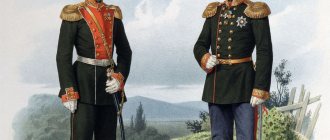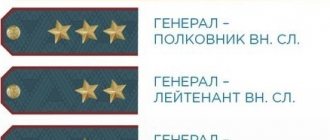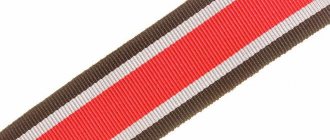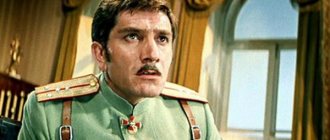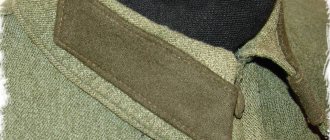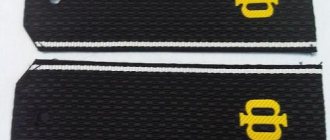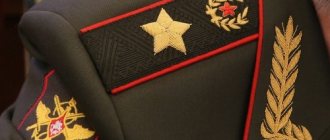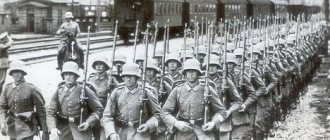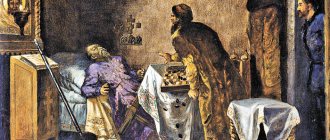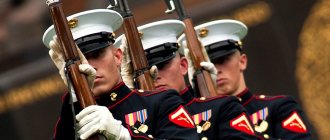The entire period of the existence of the USSR can be divided into several stages based on various epoch-making events. As a rule, changes in the political life of the state lead to a number of fundamental changes, including in the army. The pre-war period, which is limited to 1935-1940, went down in history as the birth of the Soviet Union, and special attention should be paid not only to the state of the material part of the armed forces, but also to the organization of the hierarchy in management.
Before the beginning of this period, there was a kind of disguised system by which the military ranks of the Soviet army were determined. However, quite soon the question arose about creating a more advanced gradation. Although ideology did not allow the direct introduction of a structure similar to the one currently in use, for the reason that the concept of an officer was considered a relic of the tsarist era, Stalin could not help but understand that such a ranking would help clearly establish the boundaries of the duties and responsibilities of commanders.
The modern approach to the organization of army subordination has one more advantage. The activities of personnel are greatly facilitated, since it was possible to develop individual functionality for each rank. It should be noted here that the transition to the introduction of officer ranks has been prepared for several years. The very fact that such concepts as “officer” or “general” were returning into use was perceived critically by military leaders.
Military ranks of the Workers 'and Peasants' Red Army
In 1932, a resolution of the Council of People's Commissars was issued, according to which the previously existing division into conventional categories was abolished. By December 1935, the transition to ranks was completed. But until 1943, the ranks of privates and junior officers still included job titles. The entire contingent was divided into the following categories:
- command staff;
- military-political;
- commander;
- military-technical;
- economic or administrative;
- medical and veterinary;
- legal;
- private .
If you imagine that each squad had its own specific ranks, it becomes clear that such a system was considered quite complex. By the way, it was only possible to finish off its remains closer to the 80s of the 20th century. Reliable information on this issue can be obtained from the edition of the military regulations of the Red dated 1938.
Insignia of the Red Army before the Great Patriotic War (1935-40)
The main changes in the insignia of the Red Army made in 1935
In September 1935, in the Red Army, by decision of the Soviet government (Resolution of the Central Executive Committee and the Council of People's Commissars of the USSR dated September 22, 1935), instead of the previously existing service categories of military personnel (K-1, K-2 ... K-14), military ranks were introduced, and the categories themselves have been cancelled. At the same time, the insignia of military personnel also changed. Order of the NKO USSR No. 176 dated December 3, 1935 changed the color and shape of the buttonholes and introduced a number of new elements.
Since December 1935, the main insignia were the buttonholes on the collar of the tunic and overcoat. The buttonholes for the tunic had the shape of a parallelogram, 10 cm long and 3.25 cm high, the buttonholes for the overcoat had the shape of a rhombus with rounded concave upper sides with a buttonhole height of 11 cm and a width of 8.5 cm.
The color of the buttonhole field and the color of the buttonhole edging were determined by the branch of the military:
- infantry - crimson (field), black (edging);
- cavalry - blue, black;
- artillery - black, red;
- armored forces - black velvet, red;
- technical troops - black, blue;
- chemical forces - black, black;
- aviation - blue, black;
- military-economic, administrative, justice, military-medical, military-veterinary services - dark green, red.
In addition to the insignia of positions, metal or stenciled emblems for the specialties of military personnel, introduced by order of the Revolutionary Military Council of the USSR No. 807 of June 20, 1924, were attached to the buttonholes. By order of the NCO of the USSR No. 33 of March 10, 1936, these emblems for specialties were abolished and other emblems were introduced for the branches of the military.
Examples of insignia of the Red Army, model 1935. From left to right: 1. aviation division commander, 2. major of armored forces, 3. lieutenant of artillery, 4. junior platoon commander of artillery
The sergeant major in the position of deputy political commissar in all branches of the army did not wear emblems on his buttonholes, but he had red commissar stars on both sleeves above the cuffs.
The military-political composition of all branches of the military, all military leaders at the rank of army commander and above, as well as all infantry and cavalry personnel, did not wear emblems for the branches of the military.
Privates, junior command and command staff of the Red Army
At the end of 1940, the names of ranks were changed for privates and junior command and command personnel and the insignia in accordance with ranks was changed. Red Army soldiers were required to wear new insignia from January 1, 1941. However, for a number of reasons, in many districts new buttonholes were never received and many Red Army soldiers met the Great Patriotic War with insignia of the 1935 model and emblems of the 1924 model.
The buttonholes of enlisted personnel fully corresponded in color and edging to the “standard” described above.
Buttonholes of enlisted personnel, 1935. From left to right: 1-Red Army soldier, 2-link, 3-section commander, 4-junior platoon commander, 5-sergeant major
Rank insignia according to the new system were the already familiar copper equilateral triangles covered with dark red enamel. The side of the triangle was 1 cm. There were no special tricks, the number of triangles increased in order of seniority:
- No triangles.
Red Army soldier. - 2 triangles.
Part-commander. - 3 triangles.
Junior platoon commander. - 4 triangles.
Sergeant major.
Middle, senior command and command staff of the Red Army
The command staff's buttonholes were field-colored according to the branch of service and were trimmed along the edge with narrow golden braid. They did not have a colored border.
The buttonholes of the commanding personnel and political personnel were similar to the buttonholes of the rank and file, had the color of the field and edging according to the branch of service, repeating that of the junior ranks.
The insignia for middle command and command personnel consisted of 1 (since August 1937), 2 or 3 squares (commonly referred to as “cubes” or “cubes”) measuring 1 x 1 cm made of copper coated with dark red enamel. For senior command and command personnel, from one to three rectangles (commonly called “sleepers”) made of copper measuring 1.6 x 0.7 cm, coated with dark red enamel.
Lapel insignia by rank.
A. Middle command and management personnel.
- 1 square.
Junior lieutenant (from August 20, 1937), junior military technician (from August 20, 1937). - 2 squares.
Lieutenant, junior political instructor (since August 20, 1937), military technician 2nd rank, quartermaster technician 2nd rank, military paramedic, military veterinary paramedic, junior military lawyer. - 3 squares.
Senior lieutenant, political instructor, military technician 1st rank, quartermaster technician 1st rank, senior military paramedic, senior military veterinary paramedic, military lawyer.
B. Senior command and control personnel.
- 1 rectangle.
Captain, senior political instructor, military engineer of the 3rd rank, quartermaster of the 3rd rank, military doctor, senior military lawyer. - 2 rectangles.
Major, battalion commissar, military engineer 2nd rank, quartermaster 2nd rank, military doctor 2nd rank, military veterinarian 2nd rank, military lawyer 2nd rank. - 3 rectangles.
Colonel, regimental commissar, military engineer 1st rank, quartermaster 1st rank, military doctor 1st rank, military veterinarian 1st rank, military lawyer 1st rank.
Additional insignia for the ranks of middle and senior command personnel were chevrons made of red basson (braid), which were worn on both sleeves above the cuff, cuffs on all types of clothing.
Sleeve chevrons, 1935. From left to right: 1st junior lieutenant (since 1937), 2nd lieutenant, 3rd lieutenant, 4th captain, 5th major, 6th colonel.
Additional insignia of the political personnel were red stars with a diameter of 55 mm, which were worn on both sleeves above the cuff, cuffs on all types of clothing. The stars were the same for all ranks.
The commanding staff (military technical, administrative, quartermaster, military medical, military veterinary personnel, military lawyers) did not have additional insignia on their sleeves.
Note: Many commanders who were called up from the reserves on the eve of and at the beginning of the war received clothing with insignia of the 1935 model and emblems of the 1924 model that had been previously deposited for long-term storage. Therefore, it is not surprising to find these signs in the graves of Soviet soldiers of 1941-42.
Higher command and command staff of the Red Army
The command staff's buttonholes were field-colored according to the branch of service and were edged with golden braid. The buttonholes of the commanding personnel and political personnel were similar to the buttonholes of the rank and file, had the color of the field and edging according to the branch of service.
The insignia for senior command and command personnel in the buttonholes were rhombuses 1.7 cm high and 0.8 cm wide, made of copper coated with dark red enamel, ranging from 1 to 4 pieces.
- 1 diamond
Brigade commander, brigade commissar, brigade engineer, brigintendant, brigade doctor, brigade veterinarian, brigade military lawyer. - 2 diamonds.
Divisional commander, divisional commissar, divisional engineer, divisional officer, divisional doctor, divisional veterinarian, divisional military lawyer - 3 diamonds.
Corps commander, corps commissar, coring engineer, corintendent, corvette doctor, corvette doctor corvoyurist. - 4 diamonds.
Army commander of the 2nd rank, army commissar of the 2nd rank, army engineer, army commander, army doctor, army veterinarian, army lawyer. - 4 diamonds + golden star.
Army commander 1st rank, army commissar 1st rank. - 1 large golden star.
Marshal of the Soviet Union.
The color of the buttonhole field is the same as prescribed for the corresponding branch of the military, but there are much more subtleties than for junior ranks:
- Army commanders, corps commanders, division commanders, brigade commanders have a golden narrow galloon along the edge.
- Army commanders and all commissars do not wear the emblems of the military branches on their buttonholes.
- Corps commanders, division commanders, and brigade commanders wear the emblem of their specialty.
- The commanding staff has a piping according to the color of the military branch and an emblem according to their specialty.
Additional insignia of senior command personnel were chevrons made of gold braid, sewn on both sleeves above the cuff on all types of uniforms.
Sleeve chevrons, 1935. From left to right: 1st brigade commander, 2nd division commander, 3rd corps commander, 4th commander of the 2nd rank, 5th commander of the 1st rank, 6th marshal of the Soviet Union.
Additional insignia for the highest military-political personnel were red cloth stars with a diameter of 55 mm, sewn on both sleeves above the cuff of all types of uniforms. The stars were the same for all ranks.
Senior military personnel did not have additional insignia on their sleeves.
Sources and literature
1. Order of the RVSR No. 1244 of October 2, 1924. 2. Order of the RVS of the USSR No. 807 of June 20, 1924. 3.Order of the Revolutionary Military Council of the USSR No. 1058 dated August 19, 1924. 4.Order of the Revolutionary Military Council of the USSR No. 721 dated December 2, 1926. 5.Order of the NCO of the USSR No. 176 dated December 3, 1935. 6.Order of the NCC of the USSR No. 33 dated March 10, 1936. 7.Order of the USSR NGO No. 166 dated August 20, 1937. 8.Order of the USSR NGO No. 87 dated April 5, 1940. 9.K.K.Rokossovsky. Soldier's duty. Moscow. Military publishing house 1988 10.G.K. Zhukov. Memories and reflections. APN. 1987 11.O.V. Kharitonov. Illustrated description of uniforms and insignia of the Red and Soviet Army (1918-1945). Artillery Historical Museum of the Main Artillery Directorate of the USSR Ministry of Defense. 1960 12. Red Banner Ural. History of the Red Banner Ural Military District. Moscow. Military publishing house 1983 13. Charter of the internal service of the Red Army (UVS-37). Voenizdat. 1938 Moscow.
Stalin's strange decision
The totalitarian regime, which was especially pronounced during the Great Patriotic War, did not even allow thoughts contrary to the opinion of I.V. Stalin, and his decision to return shoulder straps and officer ranks to the Red Army was openly criticized not only in the foreign press, but also by the most prominent representatives of the Soviet command.
Reform in the army took place during the hottest stages of the war. At the beginning of 1943, the officers “returned” to their previous ranks and shoulder straps . Dissatisfaction was caused by the fact that the builders of communism had long ago renounced these archaisms.
By decision of the Presidium of the USSR Supreme Court, a corresponding Decree was adopted. Until now, historians consider such a decision somewhat strange.
- Firstly, only a person who clearly understands the ultimate goals can decide to reform the army during a period of active hostilities.
- Secondly, there is a certain risk that the soldiers will feel certain steps backward, which will significantly break their morale.
Although the end justifies the means, there is always a percentage probability of a positive outcome of the reform. Naturally, the Western press saw in this the first notes of the Soviet Union's loss in World War II.
It cannot be assumed that the new shoulder straps were an exact copy of the shoulder straps of Tsarist Russia, both the designations and the ranks themselves were significantly different. The lieutenant replaced the second lieutenant, and the captain replaced the staff captain. Personally, Stalin was the initiator of the idea of using stars on shoulder straps of different sizes.
For example, the highest ranks in the USSR army have since that time been designated by large stars ( marshal - one star with a coat of arms). Only later did history reveal the real reason for the leader’s decision. At all times, the era of Peter's reforms was revered and evoked a feeling of patriotism. A return to that scheme establishing the rank of each soldier was supposed to inspire the soldiers of the Red Army. Despite the war, the USSR was preparing for the Great Victory, which means that Berlin had to be taken by officers whose ranks were consistent with the ranks of the allied countries. Was there a political motive to this? Definitely yes.
Military ranks in the 50s -80s of the century
Shoulder straps and ranks in the USSR army were revised more than once until the end of its existence. Almost every decade in history has been marked by reforms. So, in 1955, the title “Admiral of the USSR Fleet” was established. Later, everything returned to its place with the interpretation “... for consistency between the ranks of senior officers.”
In the sixties, it was decided to designate education by adding the specialty of engineer or technician. The complete hierarchy looked like this:
- junior engineer lieutenant – engineer-captain;
- Major Engineer and further respectively.
- junior technical lieutenant - captain ;
- Major of Technical Services and further accordingly.
By the mid-eighties, the idea had matured to completely remove the previously existing line between command personnel, to equate the ranks of military personnel with different education levels, to establish a single training profile, and to bring the ranks of the ground forces and naval forces into line. Moreover, this correspondence does not consist only in consonance. The fact is that exercises are increasingly being held in which several branches of the military are involved simultaneously. For effective management of the army, the names of these branches began to be excluded from ranks. By a resolution of the Presidium of the USSR Armed Forces, military ranks in the Soviet army ceased to contain special articles.
Since 1969, the procedure for wearing military uniforms has been introduced. It is now divided into front, everyday, field and work. Work uniforms are required only for privates and non-commissioned officers undergoing military service. The shoulder straps of military personnel of the ground forces, air force and navy differ in color. For the category of sergeants, foremen, warrant officers and midshipmen, the following standard is established: SV - red shoulder straps , Air Force - blue, Navy shoulder straps - black.
The corporal in pursuit wears a cloth stripe located across. The SV and Air Force shoulder straps contain the letters SA, which stands for “Soviet Army.” Navy shoulder straps are distinguished not only by color, but also by the presence of a gilded letter F. Since 1933, on the shoulder straps of a petty officer, the stripe has been located lengthwise, and before that it was supplemented by a transverse stripe, forming something like the letter “T”. Receiving the new rank of senior warrant officer since 1981 is accompanied by the addition of a third star on the shoulder strap.
The shoulder straps for the officers' dress uniform were made in gold. The edgings and stripes had the same color differences as in the previous categories. Before the 1974 reforms, the army general shoulder straps with four stars. After the transformations, they were replaced by one large star together with the coat of arms of the USSR. The same can be said about Navy .
Senior officers with the rank of marshal, in addition to the star on their shoulder straps, wore a special badge indicating the type of military service. Accordingly, it was added to the rank as an addition. This provision has been abolished only in the Russian army, which was formed in 1992. The highest rank in the Soviet Union is Generalissimo. Today the President of the Russian Federation is the Supreme Commander-in-Chief, and the marshal is considered the second in importance in the hierarchy.
Insignia of the Red (from 1943 - Soviet) Army
As insignia for the ranks of the Red Army, buttonholes were sewn onto the collars of tunics, tunics and overcoats. The rank was recognized by the shape of the geometric figures attached to the buttonholes, and the specific rank by their number. There were also additional insignia in the form of galloon charcoal chevrons sewn onto the sleeves between the elbow and the cuff. The insignia of senior command personnel were rhombuses (by the beginning of the war, replaced by 5-pointed stars), for senior officers - rectangles or, as they were also called, “sleepers”, and for junior officers - squares or cubes (in common parlance, lieutenants were called “cubes”) . For non-commissioned officers - triangles.
And so, now specifically about titles.
MILITARY RANKS OF HIGH COMMAND STAFF:
Marshal of the Soviet Union - 1 large star between the laurel branches Army General - 5 small stars Colonel General - 4 stars Lieutenant General - 3 stars Major General - 2 stars
The major general’s two stars are apparently somehow connected with the abolished position-rank of “brigade commander,” who wore one diamond on his buttonhole.
SENIOR TEAM AND MANAGEMENT STAFF:
Colonel - 4 sleepers Lieutenant Colonel - 3 sleepers Major - 2 sleepers Captain - 1 sleeper
AVERAGE TEAM AND MANAGEMENT STAFF:
Senior Lieutenant - 3 dice Lieutenant - 2 dice Junior Lieutenant - 1 dice
JUNIOR TEAM AND MANAGEMENT STAFF:
For all ranks (except for the Red Army soldier), there was a narrow strip along the buttonhole and a golden triangle was attached to the upper corner of the buttonhole. In addition, the sergeant major's buttonhole was trimmed with gold edging.
Sergeant - 1 stripe and 4 triangles Senior Sergeant - 1 stripe and 3 triangles Sergeant - 1 stripe and 2 triangles Junior Sergeant - 1 stripe and 1 triangle
RED ARMY MEMBERS:
Corporal - 1 stripe Red Army soldier - empty buttonhole.
In addition to the lapel insignia, as mentioned earlier, there were also braided sleeve stripes indicating a specific rank, and in some cases, rank.
So the chevron on the sleeves of ranks from major general to colonel general inclusive was the same. the chevron for major and lieutenant colonel was also the same, since the rank of lieutenant colonel did not exist in the Red Army until 1940. These stripes were present only for combat ranks, and they were absent for quartermasters, military technicians, doctors and military lawyers. All political instructors, regardless of rank, had a red star sewn on their sleeves with a crossed hammer and sickle embroidered on it with gold thread.
In 1943, a change occurred in the insignia of the Red Army. Lapel insignia are replaced with shoulder straps.
DECREE OF THE PRESIDIUM OF THE SUPREME COUNCIL OF THE USSR ON THE INTRODUCTION OF NEW INSIGNIA FOR PERSONNEL OF THE RED ARMY 1. Satisfy the request of the People's Commissariat of Defense and introduce, instead of the existing ones, new insignia - shoulder straps for the personnel of the Red Army. 2. Approve samples and descriptions of the new insignia of the Red Army personnel.* 3. The People's Commissar of Defense of the USSR set the deadlines for the transition to new insignia and make the necessary changes to the uniform of the Red Army personnel.**
Chairman of the Presidium of the Supreme Soviet of the USSR M. KALININ Secretary of the Presidium of the Supreme Soviet of the USSR A. GORKIN Moscow, Kremlin. January 6, 1943
ORDER ON THE INTRODUCTION OF NEW INSIGNIA AND CHANGES IN THE RED ARMY No. 25 dated January 15, 1943
In accordance with the Decree of the Presidium of the Supreme Soviet of the USSR of January 6, 1943 “On the introduction of new insignia for the personnel of the Red Army” I order:
1. Establish the wearing of shoulder straps: field - by military personnel in the active army and by personnel of units preparing to be sent to the front; everyday - by military personnel of other units and institutions of the Red Army, as well as when wearing full dress uniform.
2. All members of the Red Army should switch to new insignia - shoulder straps in the period from February 1 to February 15, 1943.
3. Make changes to the uniform of the Red Army personnel, according to the descriptions in appendices No. 1, 2 and 3.
4. Put into effect the “Rules for wearing uniforms by Red Army personnel” (Appendix No. 4).
5. Allow the wearing of the existing uniform with new insignia until the next issue of uniforms, in accordance with the current deadlines and supply standards.
6. Unit commanders and garrison commanders must strictly monitor compliance with the uniform and correct wearing of the new insignia.
People's Commissar of Defense I. STALIN
The shoulder strap is made of specially woven braid: for field shoulder straps it is made of khaki silk, for everyday ones it is made of gold fiber.
And so, the insignia is as follows:
Shoulder straps and insignia of the Soviet Union Marshals and Generals.
The size of the stars on the shoulder straps of generals is 22 mm, on the shoulder straps of generals of the medical and veterinary services - 20 mm.
Number of stars by military rank:
Marshal of the Soviet Union is one big star; Army General - four stars; Colonel General - three stars; Lieutenant General - two stars; Major General - one star;
On February 4, 1943, by order of the NKO of the USSR No. 51 in the addition to the Decree of the Presidium of the Supreme Soviet of the USSR of January 6, 1943 “On the introduction of new insignia for personnel of the Red Army,” changes were made to the shoulder straps of Marshals of the Soviet Union and shoulder straps were introduced for marshals of aviation and artillery and armored forces.
October 27, 1943 by order of the NKO USSR No. 305 on the basis of the Decree of the Presidium of the Supreme Soviet of the USSR dated October 9, 1943. Additionally, military ranks have been established for senior command personnel:
ORDER OF THE DEPUTY PEOPLE'S COMMISSIONER OF DEFENSE ANNOUNCEMENT OF THE DECREE OF THE PRESIDIUM OF THE SUPREME COUNCIL OF THE USSR “ON ESTABLISHING ADDITIONAL MILITARY RANKS FOR SENIOR COMMAND STAFF OF THE RED ARMY”
I announce for the leadership the Decree of the Presidium of the Supreme Soviet of the USSR of October 9, 1943 “On the establishment of additional military ranks for the senior command staff of the Red Army.”
Deputy People's Commissar of Defense Marshal of the Soviet Union VASILEVSKY
DECREE OF THE PRESIDIUM OF THE SUPREME COUNCIL OF THE USSR ON THE ESTABLISHMENT OF ADDITIONAL MILITARY RANKS FOR SENIOR COMMAND STAFF OF THE RED ARMY
In addition to the decrees of the Presidium of the Supreme Soviet of the USSR of May 7, 1940 and January 16, 1943, to establish the following military ranks for the senior command staff of the Red Army:
Chief Marshal of Artillery, Chief Marshal of Aviation, Chief Marshal of Armored Forces, Marshal of Signal Corps, Chief Marshal of Signal Corps, Marshal of Engineering Troops, Chief Marshal of Engineering Troops.
Chairman of the Presidium of the Supreme Soviet of the USSR M. KALININ Secretary of the Presidium of the Supreme Soviet of the USSR A. GORKIN Moscow, Kremlin. October 9, 1943
As a result of the changes at the end of 1943, the following was obtained: Marshal of the Soviet Soz - 1 large star and the state emblem above not Chief Marshal (of the military branch) - 1 large star in a wreath and the emblem of the military branch above it Marshal (of the military branch) - 1 large star B There were no changes to the generals' insignia.
Shoulder straps and insignia of SENIOR AND MIDDLE COMMANDS.
On the shoulder straps of the middle command staff there is one gap and silver-plated stars; On the shoulder straps of senior officers there are two gaps and large silver-plated stars. The stars on the shoulder straps are metal. From junior lieutenant to captain inclusive, the size of the stars from corner to corner is 13 mm, from major to colonel - 20 mm. Number of stars on the chase - by military rank:
colonel - three stars, lieutenant colonel - two stars, major - one star, captain - four stars, senior lieutenant - three stars, lieutenant - two stars, junior lieutenant - one star.
Shoulder straps and insignia of junior command and rank and file. Field of shoulder straps:
field ones - from khaki cloth, everyday ones - from colored cloth according to the type of military service.
Stripes on field shoulder straps for junior command and command personnel:
narrow - 1 cm wide, wide - 3 cm wide, longitudinal stripe on the sergeant's shoulder straps - 1.5 cm wide.
The shoulder straps of junior command personnel have stripes corresponding to their military rank:
foreman - narrow longitudinal and wide transverse stripes, senior sergeant - wide transverse stripe, sergeant - three narrow transverse stripes, junior sergeant - two narrow transverse stripes, corporal - narrow transverse stripe.
With the Bolsheviks coming to power, all military ranks and insignia were abolished. However, the experience of the civil war soon showed the need for some way of allocating command personnel. Until the winter of 1919, the process of introducing insignia was not regulated by anyone. There were insignia in the form of red armbands with the inscription of the position, a different number of red stripes around the sleeve, a different number of stars on the sleeve, headdress, on the chest, etc. These insignia were introduced by the commanders of brigades, divisions, and regiments. On January 16, 1919, by order of the RVSR No. 116, insignia of the military branches in the form of colored buttonholes on collars and insignia of commanders in the form of stripes on the left sleeve above the cuff were introduced. With this order, insignia were introduced only for combatant commanders and their deputies. Political commissars, staff soldiers, and servicemen of auxiliary services did not have any insignia according to this order. The insignia were stripes made of red fabric in the form of triangles, squares and diamonds placed above the cuffs of an overcoat, jacket, jacket, jacket, tunic or other outerwear. Above these signs was a red star cut from the same fabric with a diameter of 11 cm. for commanders from squad to regiment; diameter 14.5cm. from the brigade commander and above.
Junior command staff wore triangles:
One - squad leader Two - deputy platoon commander Three - company (division) foreman
Middle and senior command personnel wore squares: One - platoon commander Two - company commander Three - battalion commander Four - regiment commander
The senior command staff wore diamonds:
One - brigade commander Two - division commander Three - army commander Four - front commander
Very quickly other military personnel began to wear these insignia. Most often, the corresponding commander's deputies wore one badge less than the commander's. Based on the approximate correspondence of their positions to the legal status of the commanders, other military personnel began to sew on the badges.
By Order of the RVSR No. 1406 of August 22, 1919, distinctive insignia on the left sleeve above the elbow in the form of rhombuses measuring 11x8 cm were introduced for military servicemen of the military communications service. and a red armband for military commandants of railway stations and piers with the same sign depicted on it.
Until September 1935, insignia corresponded only to the position held. With the introduction of a single headdress - budenovka - in 1919, the color of the sewn star began to indicate the type of military service
infantry………..crimson cavalry……blue artillery…..orange aviation………blue sappers………..black border guards..green
At the ends of the collar of an overcoat or shirt, buttonholes were sewn in the color of the star. In the infantry, it was prescribed that the regimental number be painted on the buttonholes in black paint.
In April 1920, sleeve insignia of the military branches were introduced. These signs are made of cloth and embroidered with colored silk. The signs are placed on the left sleeve of the shirt or caftan in the middle between the shoulder and elbow.
Let's remember about the Cheka-GPU-OGPU
On June 13, 1918, the Internal Troops of the GPU-OGPU were created as a corps of troops of the Cheka. On May 25, 1919, together with other auxiliary troops, the Internal Troops became part of the Internal Security Troops of the Republic (VOKHR). VNUS) 01/19/1921 Independent troops of the Cheka were again separated from the VNUS. 02/06/1922 The troops of the Cheka were reorganized into the Internal Troops of the GPU-OGPU.
The protection of places of detention and escort were carried out by the Convoy Guard of the Republic. Until 1923, it was part of the structure of the People's Commissariat of Justice, but was operationally subordinate to the GPU.
In June 1934, all OGPU institutions were included in the all-Union People's Commissariat of Internal Affairs (NKVD), where the Main Directorate of State Security was formed. The Internal Troops were renamed the Internal Guard of the NKVD. The first uniform for the GPU bodies and internal troops was introduced on June 27, 1922. The items of clothing and equipment adopted by the GPU bodies and troops initially differed from the Red Army only in color and some details.
Uniforms and insignia underwent significant changes in 1934.
System of official ranks of the OGPU in 1922
GPU employee
Agent 3rd rank……………….1 triangle Agent 2nd rank……………….2 triangles Agent 1st rank……………….3 triangles Special assignment officer.1 square Head. operational point…..2 squares Beginning. inspection department………3 squares Head. investigative unit…….4 squares Military Director of Inspection…………..1 rhombus Head. departments of the GPU…………..2 diamonds Deputy. Beginning GPU department…………3 diamonds Head of GPU department………………..4 diamonds
The highest military rank of Generalissimo of the Soviet Union was established on June 26, 1945 and awarded to I.V. Stalin. On the dress uniform, epaulettes with the Coat of Arms and a star were used instead of shoulder straps.
The ceremonial uniform was cut in the form of a frock coat, but when Stalin saw it, he realized that with his small stature (1.63) he would look simply ridiculous in it. That's why he never wore it.
Demonstration model of a ceremonial frock coat.
This is what Stalin might have looked like.
After receiving the rank of marshal in 1943, Stalin was given a special suit. It was a closed light gray tunic with a turn-down collar and four pockets of the same cut that Soviet generals wore before the introduction of shoulder straps. The tunic had shoulder straps of the Marshal of the Soviet Union and general's overcoat buttonholes - red with gold piping and buttons. The collar and cuffs were edged with red piping. The loose-fitting trousers with red stripes were made from the same fabric as the jacket. No one else wore such a suit. In it, J.V. Stalin was depicted in official portraits and posters. He became the only uniform of the Generalissimo of the Soviet Union.
Buttonholes were the insignia of NKVD workers. In general, like all paramilitary units in the pre-war period. However, in addition to the buttonholes, insignia were also located on the sleeves of tunics and service jackets. In addition, rank could also be determined by the appearance of the departmental patch on the sleeve. The rank insignia of NKVD workers differed from those accepted in the Armed Forces. This applied not only to operational personnel, but also to NKVD troops and border guards. For the first time in Soviet history, stars appear on insignia. In addition, all NKVD employees were assigned special ranks different from military ones. Insignia introduced by NKVD order No. 152 of April 30, 1936
- two red sleeve truncated triangles - state security sergeant; - three red sleeve truncated triangles - junior lieutenant of state security; - one sleeve star embroidered with silver - lieutenant of state security; - two sleeve stars embroidered with silver - senior lieutenant of state security; - three sleeve stars embroidered with silver - captain of state security; - one sleeve star embroidered in gold - state security major; - two sleeve stars embroidered in gold - senior major of state security; - three sleeve stars embroidered in gold - State Security Commissioner of the 3rd rank; — four sleeve stars embroidered in gold, one of them at the bottom is a commissar of state security of the 2nd rank; - four sleeve stars embroidered in gold, one of them at the top is the Commissar of State Security of the 1st rank; - one large star on the cuff of the sleeve - General Commissioner of State Security.
Actually, the same thing happened on the buttonholes. The commanding officers of the GUGB wore a longitudinal tourniquet on their buttonholes, namely:
silver cord - sergeant, junior lieutenant, lieutenant, senior lieutenant and captain; golden tourniquet - major, senior major, state security commissioner of the 3rd, 2nd and 1st rank. Well, the General Commissioner of State Security, respectively.
In addition, a departmental emblem was sewn onto the left sleeve, also indicating the rank of the owner:
From a GB sergeant to a GB captain - the oval and sword are silver, the hilt of the sword and the sickle and hammer are gold. From a GB major to a GB commissar of the 1st rank - the oval of the shield is golden, all other details are silver.

